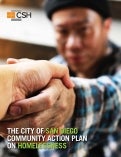Strategic Plan
City of San Diego Community Action Plan on Homelessness
Overview
The City’s Community Action Plan on Homelessness is a comprehensive, 10-year roadmap that builds on recent progress, lays out short-term achievable goals and serves as a guide for long-term success. The City Council adopted the plan in October 2019. In May 2025 leaders of the City’s Homelessness Strategies and Solutions Department (HSSD), the San Diego Housing Commission (SDHC) and the Regional Task Force on Homelessness (RTFH) presented an update to the City Council on the plan.
Vision
By working creatively and collaboratively, the City of San Diego will build a client-centered homeless assistance system that aims to prevent homelessness, and that quickly creates a path to safe and affordable housing and services for people who experience homelessness in our community.
Goals Within Reach
In three years:
- Decrease unsheltered homelessness by 50%.
- Finish the job of ending veteran homelessness.
- Preventing and ending youth homelessness as outlined in the San Diego County Coordinated Community Plan to End.
Recommended Actions
- Advance high-impact solutions. Developing long-term housing takes time. Aggressive measures must be taken now, and the system needs to be flexible over time to meet changing needs and circumstances.
- Support strong leadership. Creation of a citywide leadership council and project manager to keep progress on track.
- Invest in new housing and service options. Increase temporary crisis response solutions while also investing in permanent long-term units.
- Quickly address key issues. Address items needing immediate attention, including adding behavioral health resources, outreach coordination, voucher utilization, and appropriate staffing entities for implementing this plan.
Key Strategies
- Implement a systems-level approach to homelessness planning. Build capacity and infrastructure around city-level governance, strategic thinking and systems change to support the articulated goals.
- Create a client-centered homeless assistance system. Create a homeless assistance system that centers around clients and values client feedback in system design and resource allocation.
- Decrease inflow by increasing prevention and diversion. Work with other regional systems to prevent homelessness when possible and divert people from the system altogether.
- Improve the performance of the existing system. Review current practices, performance and metrics to move from project-level thinking to system-level thinking.
- Increase the production of/access to permanent solutions. Identify low-income and affordable housing options to increase opportunities to provide greater access to permanent housing.
Leadership Council
The plan recommended the creation of the Leadership Council to facilitate cross-agency collaboration, align resources toward systems-level thinking and ensure accountability. The Leadership Council will review progress, problem-solve when challenges arise, identify funding and resources for implementation, and create an appropriate level of accountability and insulation from political issues.
Implementation Team
The plan's development included creating a Steering Committee consisting of key staff members from major funding and policy-making agencies in the City. This group now serves as the staff implementation team to carry out the detailed actions within the plan.

